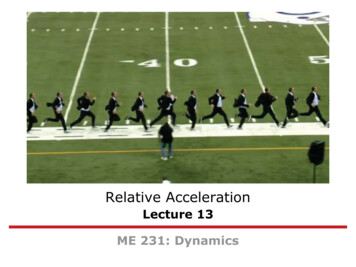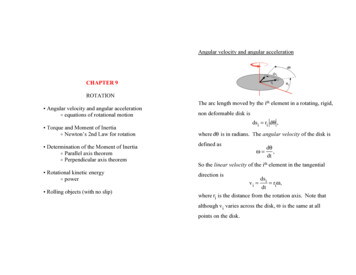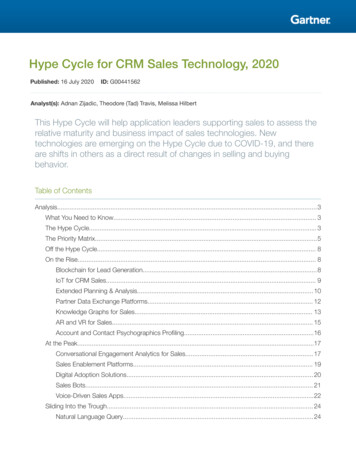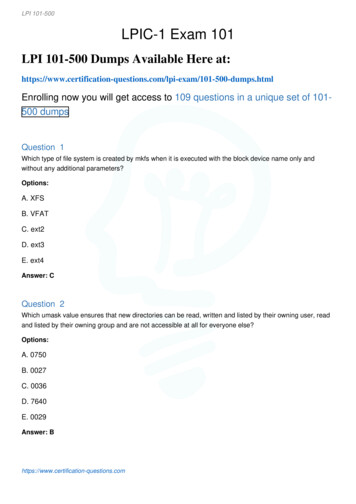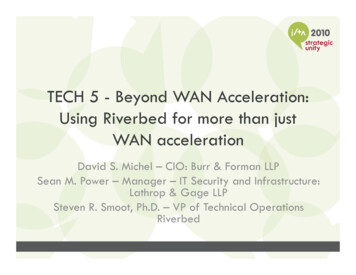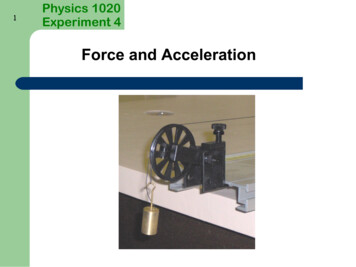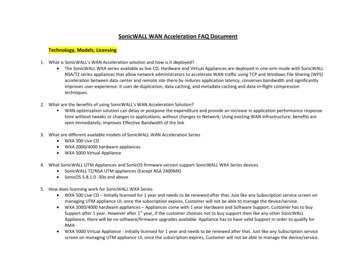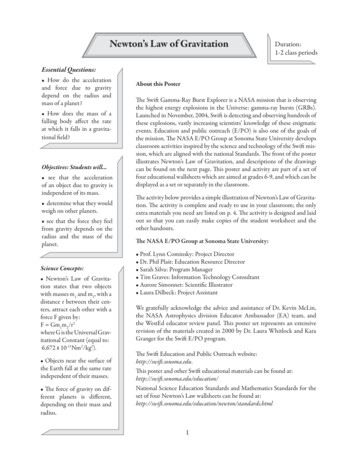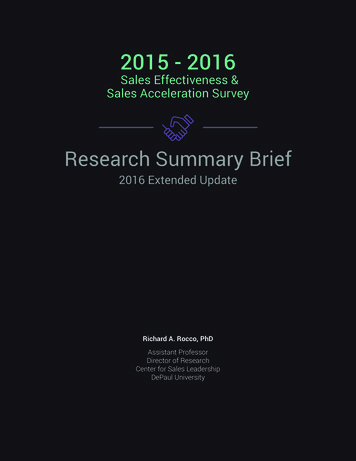
Transcription
2015 - 2016Sales Effectiveness &Sales Acceleration SurveyResearch Summary Brief2016 Extended UpdateRichard A. Rocco, PhDAssistant ProfessorDirector of ResearchCenter for Sales LeadershipDePaul University1
2015-2016Sales Effectiveness & Sales Acceleration SurveyResearch Brief - 2016 Extended UpdateIntroduction:As the sales landscape continues to change for organizations, the Center for Sales Leadership atDePaul University regularly conducts best-practices research to provide sales professionals andacademics with timely information, insights, and direction on a range of sales and salestechnology topics.This research study is an extension of our ongoing sales effectiveness research to develop anunderstanding of the one of the rapidly evolving areas of sales today: sales acceleration technologyproducts and services. Utilized by an increasing number of leading sales organizations, the evolvingarea of sales acceleration products and services represents the application of various technologiesto an organization’s existing CRM (sales and marketing automation) systems to enhance both theeffectiveness and efficiency (velocity) of the selling process. The present research reports bothcurrent perspectives and future directions on this important topic respective of salesorganizations today.Salesgrowthover the coming year24.9%24.8%ntoucdhea 6,170 per salespersonhwtorgytheslogsalowrtoegNhn teclesanisntNettmeseved inExpectgnrainitnittmenExpected inves2 9,721 per salesperson
Research Objectives:Selling effectiveness requires a mix of organizational practices and operational behaviors, inclusiveof CRM and sales acceleration technologies that drive sales performance.The primary objectives of this research study are:123Profile sales organization performance metrics and measure the relative effectivenessof these organizations in key areas including sales growth, sources of sales growth, quotaachievement, and turnover.Understand current use and future directions on sales acceleration technologies and servicesin six key areas including sales communications/dialing technology, gamification, predictiveintelligence and lead scoring, data visualization and application experience, datasubscribers and enrichment, and lead flow managementReport current findings as well as significant relationships specific to any operationalbehaviors (i.e. sales process, technology utilization) and organizational activities(sales talent) that impact performance.Research Methodology:The survey information was collected primarily from a sample of small-medium businesses (SMBs)as well as large organizations across the United States and Canada. Online survey software wasused to collect and analyze the data in the survey. A total of 149 firms responded to the survey with127 usable responses for analysis.3
2015-2016Sales Effectiveness & Sales AccelerationSurvey Summary of FindingGeneral Respondent Profile:The survey results related to 127 respondents reveal several significant facts: Respondents are evenly distributed among senior, middle, and field level management The majority of sales organizations (80%) had under 250 sales associates. The sales organizations reported a 60/40% split between outside/field and inside sales roles Half of inside sales organizations perform both inbound and outbound activitiesespondern27ts1Who?80%Had under 250 sales associates60/40%Split between outside/field and inside sales roles50%Perform both inbound and outbound activities4
Performance Profile:The survey results related to performance reveal several significant facts: Survey respondents reported an impressive net sales increase of 35.2% over prior yearAcquisition of new business has accelerated, reaching 51% of annual salesA small part (25%) of the sales force exceeded quotas, delivering most of the gainsThe typical deal size range reported was between 10k and 50kCurrent levels of missed quotas are far too high (42%) and correlated with the significantturnover of 26.9% reported for inside sales positions and 25.7% for outside sales positions The reasons for turnover were driven by voluntary resignations (50%) followed by involuntarydismissals (33%) and retirement (22%) The average cost to replace a salesperson is 97,690 and takes between 3.69 months (insidesales) and 5.42 months (field sales) to fill a positionSales Acceleration Profile:The survey results related to sales acceleration technologies and services provide severalsignificant facts: The most utilized CRM system to manage the sales process is Salesforce.com (54%) withcompanies reporting average use of 5 years across their currently installed CRM systems Only 4% of respondents were presently not using a CRM system A significant (76%) number of the organizations utilize a defined sales process, with the “top 3”most utilized sales models as value selling (various), strategic selling (Miller Heiman), and FAB A significant number (38%) of respondents were presently not utilizing any of the salesacceleration technologies, which represents an important opportunity for technology providers The sales acceleration technologies utilized the most by sales organizations include datasubscribers and enrichment (40%) and communications/dialing technology (38%) followed bypredictive intelligence and lead scoring (21%), lead flow management (19%), gamification (12%),as well as data visualization and application experience (7%)Top 3 sales investment areas of 201637%Lead flow management33%32%Predictive intelligence /lead scoringSales communication /dialing technology5
Sales Acceleration Technologies and Services Highlights and Insights:The survey data and verbatim responses provided additional context to extend some furtherinsights regarding usage of current sales acceleration technologies and services. While the sixdifferent sub-group sample sizes were too small to provide reliable statistical analysis, the followingare key findings:Communications/dialing technology: Respondents had used their noted communications/dialing technology for an average of 2.52years with an initial implementation time of 4.74 weeks. Respondent primary reasons for selecting their communications/dialing provider (in rank order):#1 CRM Integration#2 High volume automated dialing (software),#3 (statistical tie) click-to-call dialing, analytics and reporting, inbound call routing Key Metrics reported (on average) from respondents utilizing these technologies:Predictive intelligence and lead scoring:# dials per65 averageday / salesperson Respondents have been utilizing their currentpredictive intelligence/ lead scoring productsand services an average of 2.47 years Most noted reasons for selecting: Increasingqualified pipeline and better information/support to sales team for customer calls.Data visualization and application experience:# call attempts21 averageto reach a lead Respondent satisfaction (7-point Likert scale),in this category was 5.33 regarding theircurrent product and service, which suggeststhat respondent firms are presently “somewhatsatisfied.” Respondents have been utilizing their currentdata visualization and application experienceproducts and service an average of 3.03 years.Data subscribers and enrichment:# conversations3.1 averageper day / salesperson Respondents have been utilizing their currentdata subscriber and enrichment products andservices an average of 3.03 years Most noted reasons for selecting: Better dataquality, easier access, and better/deepercontent for contacts6
Lead flow management: Respondents have been utilizing their current lead flow management products an average of3.71 years, which is the longest use of any sales acceleration product category in the survey. Most noted reasons for selecting: Ease of integration with CRM, marketing preference, andbetter quality (versus quantity) leads.Gamification: Respondents have been utilizing their current gamification products an average of 1.02 years Most noted reasons for selecting: Driving CRM adoption, and knowledge retention/trainingSales Acceleration Technologies - Looking to the futureRespondents provided additional data and verbatim responses regarding expected salesorganization growth, salesperson investments (training and technologies), and interests in salesacceleration technologies in the coming year: Continued growth in the size of sales organizations: Firms expect to grow their salesorganizations, on average, 24.9% over the coming year. Planned headcount growth is greateracross inside sales roles (30.6%) and slightly lower planned growth across field sales roles(16.3%). Continued strong sales growth: Respondents expect 24.84% overall net sales growth for theorganizations over the next year. The most significant contributor to that growth, on average,will come from inside sales compared to outside/field sales. Continued investment in salesperson training and sales technology: Firms expect to invest anaverage of 9,721 in sales training and 6,170 in sales technology per salesperson over the nextyear. Increasing interest in sales acceleration technologies and services: Given the lower penetration(60%) in the current use of sales acceleration technology and services across all respondentorganizations, the “top 3” greatest areas of interest in additional investment in the comingyear are lead flow management (37%), predictive intelligence/lead scoring (33%), and salescommunications/dialing technologies (32%). Other areas of interest: Althoughslightly lower, data visualization andapplication experience (24%), aswell as gamification (19%) and datasubscribers and enrichment (19%) werenoted as areas of increased interest ininvestment in the coming year. “Other”noted areas of interest (verbatimresponses) included sales enablement/playbooks, sales content creation, andsales process.GamificationSales communications / dialing technologyPredictive intelligence and lead scoringData visualization and app experienceData subscribers and enrichmentLead flow managementOther010203040750
Organizational and Operational Behaviors – Key insights from researchIdentifying and retaining talent is a challenge for companies:Consistent with our past sales effectiveness research, sales organizations continue to need todevelop more effective methods designed to secure and retain sales talent. The high annualturnover for both inside and outside roles of 26.9% and 25.7% respectively is costly for firms wherean average cost per turnover of 97,690. Combined with planned hiring growth rate targets of30.6% and 16.3% for inside and outside sales roles respectively, talent recruiting and retentioncontinues to be a critical challenge for sales organizations.Sales process usage is increasing, but could be improvedIn capturing a firm’s use of a sales process, 76% of respondents reported utilization of a definedsales process. The specific sales process identified most (top 3) by the respondents includedvarious value selling (48%), strategic selling (32%), and FAB models. While the current studyreflects an increasing utilization of defined sales processes, consistent and disciplined use of salesprocesses continues to be a challenge for most organizations with only 58% frequently or alwaysutilized by the sales organization. Those firms noting a higher frequency of use with a sellingprocess had a stronger correlation to meeting/exceeding quota and increased sales growth.Adoption and use of sales acceleration technologies is becoming essentialWhile adoption (96%) and use (5 year average) of CRM systems is strong with the firms in this study(96% presently utilize a CRM system), only 62% are further leveraging its capability to increase saleseffectiveness through the adoption and use of sales acceleration technologies and services.Simply, there was a statistically significant difference (p .05) between the group of firms reportingintegration and use of at least one type of sales acceleration technology and the group of firms notpresently using any type of CRM respective of sales growth, meeting/exceeding quota achievement,and turnover. In this particular study, on average, the firms leveraging sales accelerationtechnologies had improved performance.Sales Acceleration Technologies – Further extended insights from qualitative researchFollowing the close of the main electronic survey, 26 survey participants that noted “open to followup interview” were contacted and 8 (31%) participated in a 15-minute follow-up Q&A interview underthe premise of anonymity (no identifying information).8
The following are a few prominent themes and feedback from the interviews:Sales Process: The interviews consistently brought up the need for Sales Accelerationtechnologies to help with establishing/supporting a disciplined sales process in various stagesof the sales process. Given the variety of sales skills within their inside sales teams (and highturnover), technology that can help “discipline reps” to the variety of steps in the sales processwould be very helpful and provide great value to their sales organizations. They also mentioned aneed for providing tools that introduce early stage to late stage questioning to help their reps getthrough qualifying. Basically they see the technology as a means to deliver timely support toolsaligned within each phase of the sales process to provide a “best practice” environment across theirsales teams.Predictive Intelligence/ Lead Scoring – While all valued the benefits of predictive intelligence,the common point across the interviews was that their sales reps don’t take the time to put goodinformation into the system. Better lead quality (information) and lead scoring had the greatestpractical weight in SA technology for them and valued the option of data subscription resources. Afew noted that better lead scoring will still need to allow reps flexibility to be the drivers to “decipherthe best ones.”EndRichard A. Rocco, PhDAssistant ProfessorDirector of ResearchCenter for Sales LeadershipDePaul University9
various value selling (48%), strategic selling (32%), and FAB models. While the current study reflects an increasing utilization of defined sales processes, consistent and disciplined use of sales processes continues to be a challenge for most organizations with only 58% frequently or always utilized by the sales organization.
